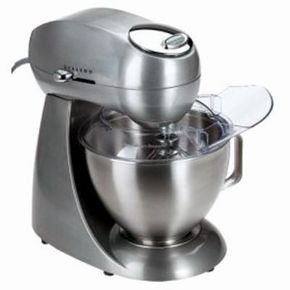How to Use a Stand Mixer
Q. I just moved into a new house. What small kitchen appliance is a must-have for my new kitchen?
A. Kitchen tools come and go. Some work and some don't -- most end up collecting dust because they are hard to use and tough to clean.
One tool that has stood the test of time is the stand mixer. You may have watched your grandmother use one as she was mixing dough for your favorite holiday bread. Mom probably let you scrape the bowl clean after she whipped up one of her special cake frostings. You may have received one as a wedding gift and never used it. Whatever the situation, the stand mixer is definitely a kitchen tool worth examining.
Advertisement
Q. I'm thinking about purchasing a stand mixer. Are there different types to choose from on the market?
A. Thanks to American ingenuity, we have several choices when it comes to stand mixers. Before purchasing one, do your homework. Decide how often you bake and the type of baking you do. Less expensive mixers may be the right choice for casual bakers, while the more expensive models with a variety of attachments may suit more serious bakers.
Q. What is the advantage of buying a stand mixer over a portable one?
A. Stand mixers offer several advantages over portable mixers. First, all stand mixers offer hands-free operation, allowing you to work on other parts of the recipe while batters and dough are mixing. Second, the design provides for more even mixing, and finally, since the machine is stationary, the chance for accidental spills is also reduced.
Q. Which attachments do I need?
A. This choice depends on both the model you choose and the types of baking you do. Less expensive models may only come with beaters. For the occasional baker this is really the only attachment you will need. You can easily make most cake and cookie batters, frostings and icings with the beater attachment.
Bread bakers and serious cake makers might want to purchase a model with interchangeable attachments. The three most common are the whisk, paddle, and dough hook; each is designed for a specific mixing technique.
The whisk incorporates air into liquid mixtures, such as egg whites and cream. As the whisk rotates faster the mixture becomes thicker and creamier. Meringues, frostings, and thick sauces are all made using this attachment.
The paddle is used for mixing thicker and heavier cookie and cake batters where the incorporation of air is not critical to the recipe.
The dough hook is used for mixing bread dough of all kinds. The design of the hook is excellent for pulling sticky dough away from the side of the mixing bowl.
All models come with a large mixing bowl; some come with extra smaller mixing bowls.
Q. How many speeds do I need?
A. A simple way to determine the number of speeds you might require is to think of speed in ranges of slow, medium, and fast. A model with numerous speeds is really just offering more speeds in each range.
Q. What else should I know about stand mixers?
A. Whether you purchase an inexpensive model or a deluxe one with all the attachments, remember that the mixer is only a tool. Always follow the recipe.
Most recipes call for exact ingredient amounts, so measure carefully.
If the model you purchase does not have a timer, it's probably a good idea to purchase one. The timer will help ensure that you are beating the mixture to the correct consistency.
It is always a good idea to clean as you go; batters dry quickly and make cleanup more difficult.
Your baking magic can begin, now that you're better acquainted with this helpful and easy-to-use kitchen tool.
The cookie press is an easy way to create fun and festive cookies. Continue to the next page to find out more about the cookie press.
For more helpful kitchen appliance tips and recipes, see:
- Introduction to Cleaning Small Kitchen Appliances
- Introduction to How Food Processors Work
- Small Appliance Repair Basics
- Baking Cookies: Baking Shaped Cookies
- Chocolate Waffles Recipe
